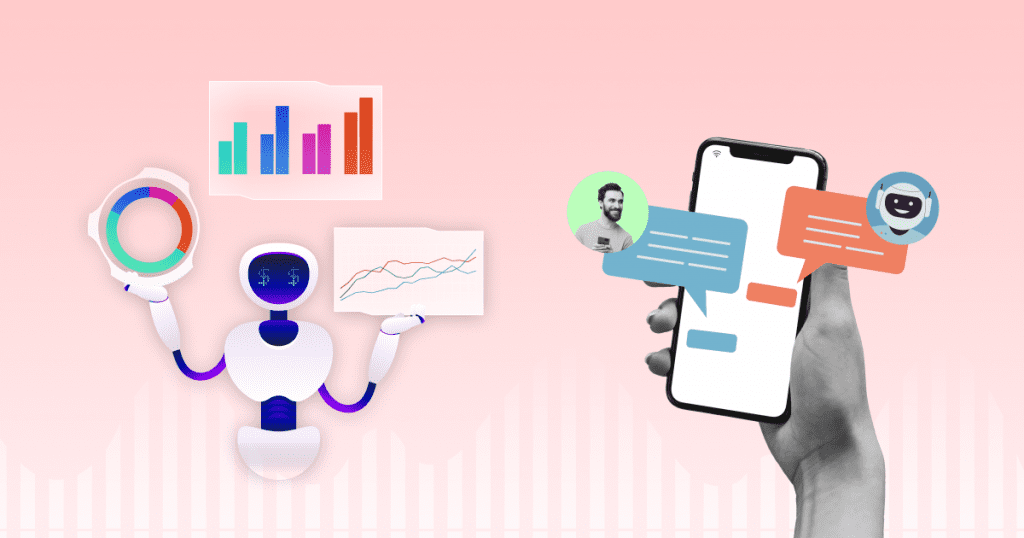A chatbot is here to stay with your business and the best part is your business will be boring without the fun party that Chatbot creates with your business and customers.
From uninterrupted conversation to taking customer orders, it has all been covered. In the chaotic world, chatbots can make your work easier. In this article, you will find everything that you need to know about Chatbot statistics, let’s find out in this blog.
Before diving into detailed statistics for the Chatbot, let’s understand the key analytics which is up to date for the chatbot statistics.
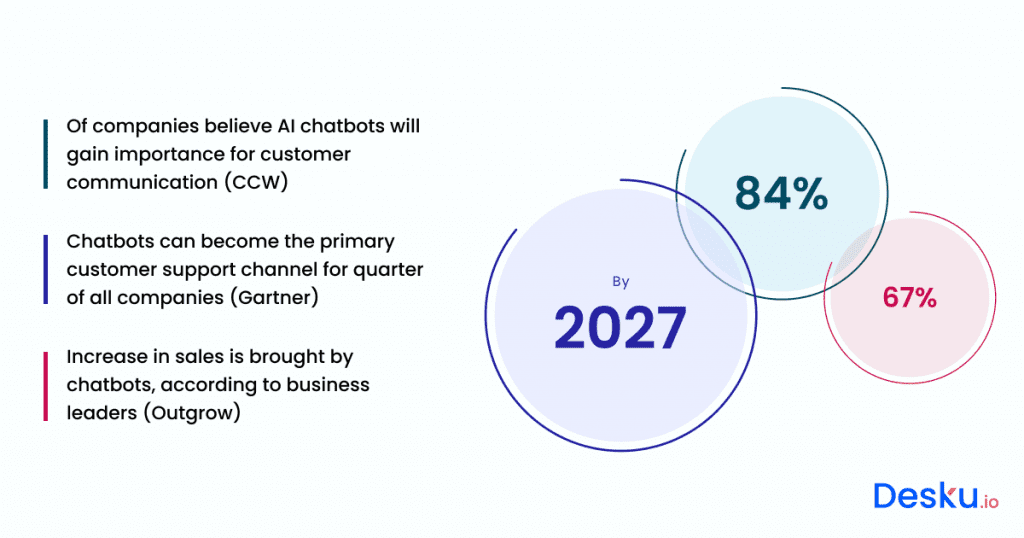
What is Chatbot?
As businesses continue to recognize the value of this technology in enhancing their marketing strategies and customer support systems, the adoption of chatbots is on the rise.
Desku, at the forefront of this innovation, contributes to the expanding market, which is projected to reach a staggering $994 million by 2024. With Desku’s advanced chatbot solutions, companies are well-equipped to meet the evolving demands of digital customer engagement.
✅ Exploring Chatbot Trends and Statistics
We’re examining the current perspectives on the diversity of chatbot platforms, their challenges, and emerging trends in the business world.
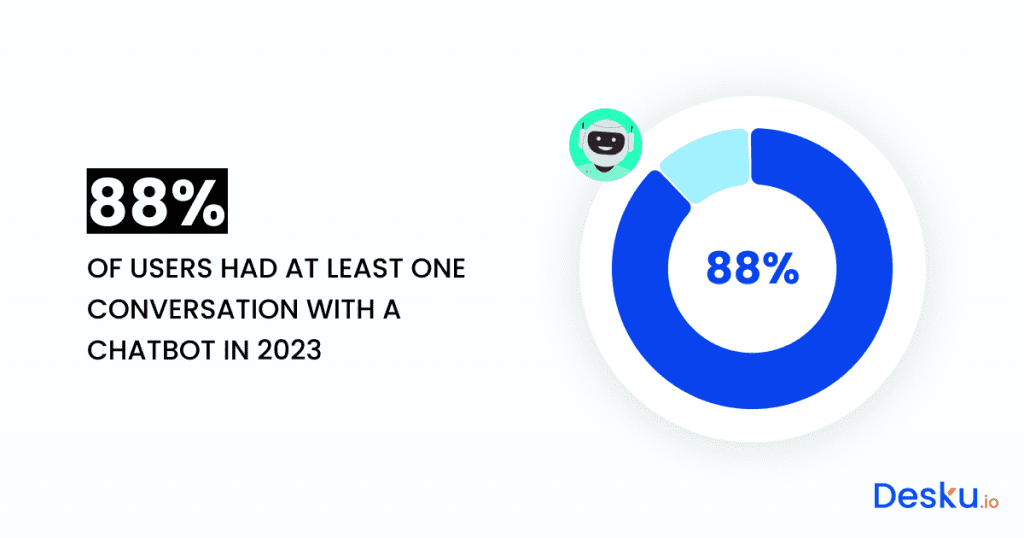
🤖 A significant 88% of users engaged in at least one interaction with a chatbot during 2022, as reported by Tidio.
Increasingly essential in facilitating customer-business communication, chatbot technology is now a constant presence. Typically located in the lower right corner of a website, these chatbots stand ready to address customer inquiries around the clock, every day.
Consequently, a significant majority of customers have engaged with chatbots at least once, with these interactions becoming increasingly frequent.
🤖 In the B2B sector, 58% of companies now actively incorporate chatbots, surpassing the 42% in the B2C sector
This trend highlights the greater prevalence of automated communication in B2B environments, largely due to chatbots’ effectiveness in generating leads, a crucial aspect for B2B businesses.
Regarding customer engagement, research indicates that the primary reasons for interacting with chatbots include seeking assistance during purchases, scheduling meetings, or subscribing to email newsletters.
These tasks, efficiently handled by chatbots, can significantly reduce the workload for businesses.
🤖 By 2024, it’s anticipated that chatbots will save companies up to 2.5 billion work hours
This efficiency is achieved as chatbots streamline repetitive tasks like addressing FAQs, gathering feedback, or lead qualification, thereby easing the burden on support, marketing, and sales teams.
🤖 A notable 59% of customers expect a chatbot response within just 5 seconds.
This expectation is often met due to the absence of human delays in chatbot operations.
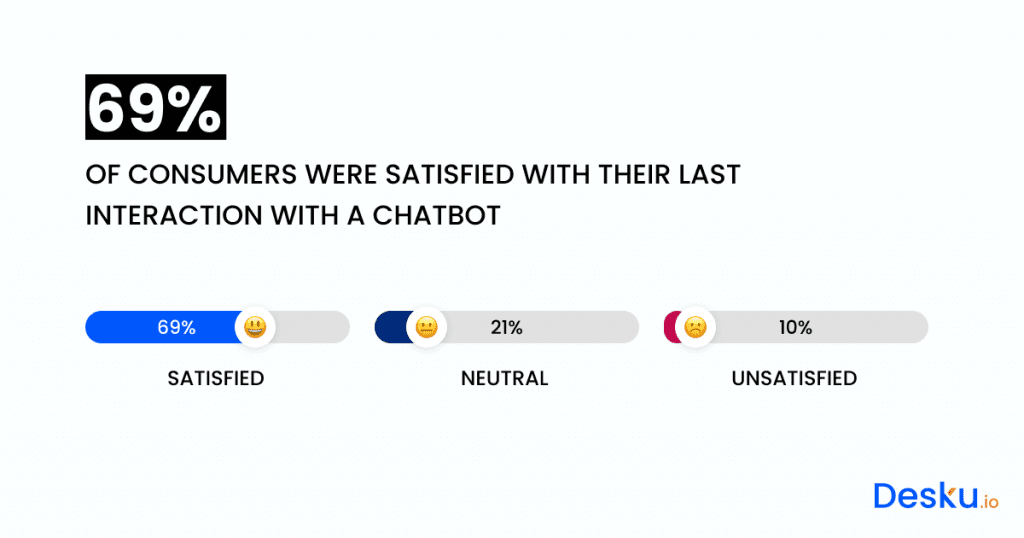
🤖 Satisfaction rates are high, with 69% of consumers content with their latest chatbot interaction (Tidio).
This is a commendable achievement for automated assistants. Meanwhile, 21% of users remained neutral, and a mere 10% expressed dissatisfaction with their chatbot experience.
🤖 The cost for a single interaction with a chatbot ranges between $0.50 and $0.70, as per Juniper Research’s findings.
When compared to the annual salary of a customer support agent, averaging at $40.7k or about $19.5 per hour, the affordability of chatbots becomes evident. This cost-effectiveness is highlighted as a key advantage of chatbot implementation.
🤖 A significant 48% of users prioritize the,
effectiveness of a chatbot in resolving issues over its personality, according to ServiceBell.
While functionality is paramount, it’s also beneficial to invest in the chatbot’s personalization. Ensuring it communicates in a human-like manner and aligns with your company’s tone enhances user experience, a practice highly recommended in the realm of chatbots.
🤖 Chatbots are involved in 39% of all interactions between businesses and consumers, as reported by Comm100.
This statistic underscores the growing trend towards automation in business, simplifying tasks for agents and accelerating problem-solving for customers.
However, challenges in the adoption of chatbot technology remain:
- 56% of businesses believe that conversational AI, particularly chatbots, disrupts their industry.
- Userlike reports that 60% of consumers still prefer waiting for a real agent’s response over an instant chatbot reply.
This hesitation often stems from a belief that human agents are more capable of understanding and effectively resolving issues. Yet, it’s important to note that chatbot technology is continually advancing in its ability to comprehend user messages and underlying sentiments.
Despite these challenges…
🤖 An overwhelming 84% of companies, according to CCW, foresee AI chatbots becoming a crucial element in customer-business communication.
This statistic suggests that chatbots are more than a fleeting trend; they are evolving into an essential component of future business communications.
✅ Sales and Marketing Chatbot Statistics
Sales and marketing chatbots have risen and it is in demand which it is giving high escalation in the business as they have helped in capturing leads, connecting with them, having conversations and much more.
Let’s understand some of the best insights about Chatbot in sales and marketing;
Here are the key AI chatbot statistics for 2024:
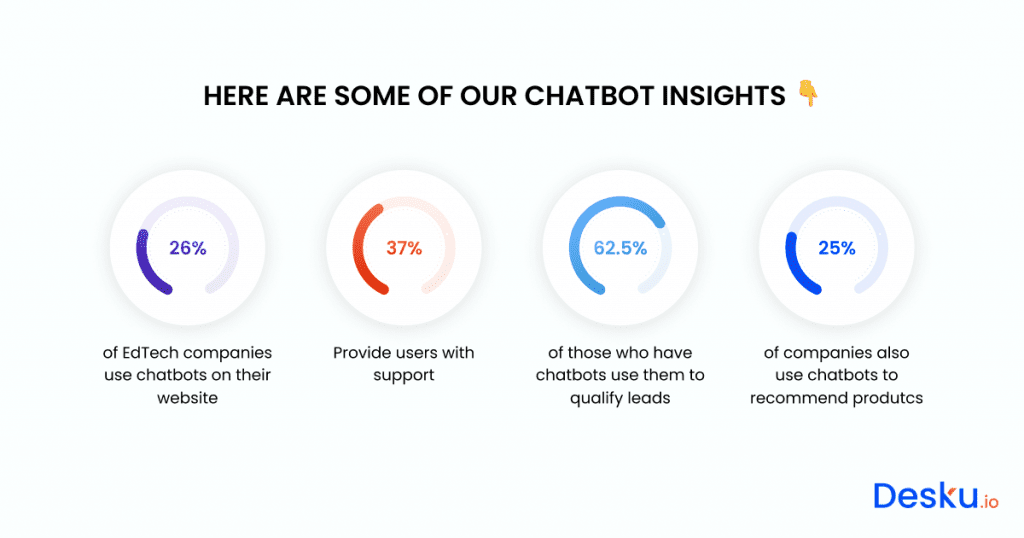
🦾 AI chatbots have been shown to halve the workload of Sales Development Representatives (SDRs) by handling client FAQs.
This was particularly evident post-client registration for meetings. After clients completed lead qualification queries, the AI chatbot stepped in to maintain the dialogue and address any additional questions about the company or its products. This strategy led to increased deal conversions, as sales managers could then focus on specific customer pain points during meetings.
🦾 Companies utilizing AI chatbots report a threefold increase in sales conversions compared to those relying on traditional website forms.
🦾 Chatbots powered by generative AI have been found to boost sales conversions by 2.5 times.
This improvement was noted when clients incorporated generative AI for lead qualification, scoring, and FAQ responses, thereby optimizing SDR time and prioritizing leads more effectively.
🦾 Chatbot-led lead qualification quizzes outperform static forms by 20%.
Clients often abandon lengthy forms due to their complexity. In contrast, chatbots facilitate a more engaging interaction, presenting one or two questions at a time, which simplifies the lead qualification process.
🦾 Transitioning to AI chatbots for responding to FAQs post-automatic lead qualification has been shown to enhance sales conversion rates.
🦾 Our statistics indicate that half of the customers prefer interacting with AI chatbots.
🦾 One-third of leads express their concerns about a company or its products to an AI chatbot when it’s introduced immediately after lead qualification for a sales call.
This approach provides managers with richer context before engaging in a sales conversation, as the AI chatbot relays this crucial information.
These findings underscore the significant impact of AI chatbots in enhancing sales and customer engagement processes.
✅ Role of Chatbot in SaaS Statistics
Chatbots in the SaaS Sector: Key Statistics 🚀
A significant 58% of companies engaging with chatbot technology are in the B2B realm, with a notable 65.1% operating within the SaaS industry.
🚀 According to FinanceOnline, a third of AI startup founders predict chatbots will emerge as the leading customer technology in the next half-decade, revolutionizing customer interactions.
🚀 Chatfuel’s data reveals that 38.9% of chatbot-utilizing businesses belong to the IT software and services sector, highlighting the technology’s relevance in this field.
In practice, the integration of chatbots in SaaS companies has been instrumental in boosting key metrics like signup rates, service activation, and overall purchase conversions. Additionally, these automated assistants significantly reduce the workload on support teams, streamlining customer service processes.
🚀 Impressively, Tidio reports that in certain industries, chatbots have achieved conversion rates as high as 70%. This statistic underscores the potent impact of chatbots in enhancing business performance and customer engagement across various sectors.
✅ Ecommerce Chatbot Insights
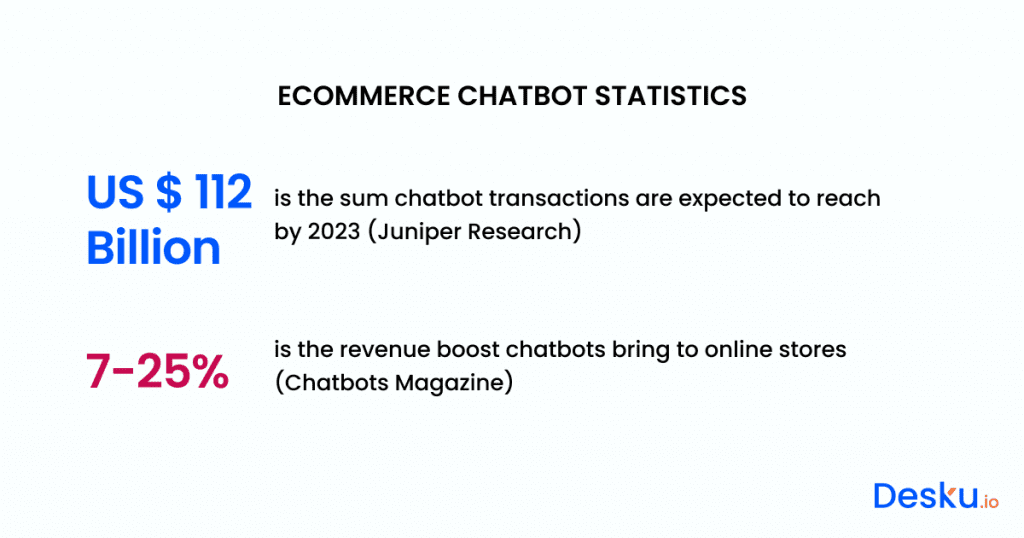
Exploring Chatbot Effectiveness in 2024;
⭐ A mere 9% of global online retailers have integrated chatbots on their platforms, according to the latest Statista report. This indicates a gradual yet steady adoption of chatbot technology in the eCommerce sector, mirroring trends in other industries.
⭐ Juniper Research forecasts that by 2024, chatbot-driven transactions in the eCommerce world are set to hit an impressive $112 billion. This growth highlights the substantial value chatbots bring to online stores, aiding customers in product selection, offering additional purchase options, and tackling issues like cart abandonment. The potential for chatbots in eCommerce is boundless.
⭐ Chatbots Magazine reveals that chatbots have begun to enhance eCommerce revenues, contributing to an increase of 7-25%. This significant growth occurs as more eCommerce businesses start to embrace chatbot technology across various platforms, including websites, social media, and messaging apps.
⭐ Invesp’s data shows that 34% of online retail customers are receptive to using chatbots. This rate of acceptance surpasses that in sectors like finance (20%) and telecommunications (25%), indicating a higher openness towards chatbot technology in the online retail space.
Chatbots are proving to be a valuable tool in eCommerce, streamlining processes such as order status updates and product searches, thereby enhancing the overall customer experience.
✅ Customer Service Chatbot
Across various industries, an increasing number of brands are turning to chatbots to elevate their customer support and overall experience.
💬 Gartner forecasts that by 2027, chatbots will emerge as the leading customer service channel in one-fourth of all businesses.
Chatbots significantly cut down response times, efficiently handling straightforward inquiries without human intervention. When configured properly, they can also seamlessly direct more complex conversations to the appropriate customer service agents.
This technology offers dual benefits: customers enjoy quicker responses, and support teams are relieved from monotonous tasks, allowing them to focus on more complex issues.
💬 According to Tidio, 62% of users prefer interacting with a customer service chatbot rather than waiting for a human agent’s response.
The primary appeal of chatbots lies in their speed and round-the-clock availability, making them a preferred choice for consumers seeking immediate assistance.
💬 Simplr reports that 80% of consumers are open to using chatbots, especially if they can easily switch to a human agent when needed.
While some customers find chatbots frustrating due to difficulties in reaching human support, the key is to create a balanced customer service system that effectively integrates both human agents and automated assistants. It’s essential to always provide an option for human interaction.
The data indicates that customers value quick resolutions to their issues. Common repetitive queries present an opportunity to implement an FAQ chatbot, which can address these questions
without human intervention, thereby enhancing customer satisfaction with prompt responses.
💬 PSFK’s research shows that 74% of customers would opt for a chatbot over a human agent for simple queries.
This statistic highlights a growing preference for automation in customer service, not just for the ease of support teams but also for the convenience of customers themselves. By leveraging chatbots for routine inquiries, businesses can streamline their customer service, ensuring efficiency and satisfaction on both ends.
✅ Overall chatbot usage and engagement insights
The increasing presence of chat icons in the lower right corners of websites is a testament to the rising trend of chatbot usage and engagement. Let’s explore the current landscape of chatbot adoption in businesses and their interaction with consumers.
♦︎ A staggering 1.4 billion individuals are now using messaging apps, showing a readiness to communicate with chatbots.
♦︎ The most common application for chatbots, identified by Drift, is providing quick responses in emergencies, followed closely by resolving complaints or questions.
♦︎ Drift also notes that 35% of users turn to chatbots for resolving issues or obtaining in-depth answers.
♦︎ In the business world, 58% of B2B companies have incorporated chatbots on their websites, a higher rate compared to the 42% observed in B2C companies.
♦︎ Mobile Marketer highlights that 40% of millennials engage with chatbots daily, indicating a generational shift towards this technology.
♦︎ Matthew Barby’s research reveals that while lower engagement bots see response rates between 35-40%, superior chatbot experiences can skyrocket these rates to 80-90%.
♦︎ Since 2019, chatbot usage has soared by 92%, as per Drift, marking it as the fastest-growing brand communication channel.
♦︎ Drift further reports a significant increase in chatbot usage for various purposes, including making purchases, scheduling meetings, and signing up for mailing lists, which more than doubled from 2019 to 2020.
♦︎ Spiceworks finds that 46% of companies using AI chatbots or intelligent assistants employ them for voice-to-text dictation.
♦︎ The IT department is the primary beneficiary of chatbot technology in 53% of organizations, as observed by Spiceworks.
Finally, research states that 87.2% of consumers rate their chatbot interactions as neutral to positive, reflecting a generally favorable reception of this technology.
Role of Desku Chatbot in Business
Desku is an all-in-one AI-powered customer support platform that helps all business owners manage their customer queries from different platforms.
Desku consists of the best feature, which is a no-code chatbot builder, that allows to communicate automatically with customers. The chatbot builder platform of Desku consists of a drag-and-drop conversational interface to build a chatbot for all business types.
When it comes to E-commerce platforms, like Shopify and WooCommerce, you can customise the chatbot according to it and therefore implement it in the business.
Desku has some of the best ways that help in the implementation of a chatbot along with taking care of branding of the business, which in turn can be easily edited or deleted. Human handoff is much easier and customers or visitors can talk to human support agent whenever they want and required.
Final words on the overall Chatbot Market
Chatbots are ever-emerging spaces where there is always going to be escalation no matter what. From the use case of chatbots to the implementation of it in the business, it will help to reduce the workload by almost 80%.
When you implement and build the right chatbot from the chatbot builder, there is no going back to keeping the normal chat widget on the website. In this blog, we have stated almost all the statistics that are important to run or implement in a business.
Get a chatbot, and save your time!

